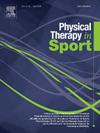Quadriceps femoris strength deficits early in rehabilitation after ACL reconstruction identify risk of future contralateral ACL injury following return to sport in young athletes: A Preliminary analysis
IF 2.2
3区 医学
Q1 REHABILITATION
引用次数: 0
Abstract
Objective
To test the relationship between quadriceps femoris (QF) strength 3 months after ACLR and long-term outcomes after ACLR.
Design
Prospective, case-cohort.
Setting
Laboratory.
Participants
51 (mean age:15.6 ± 2.2 yrs) athletes after ACLR.
Main outcome measures
1) “Early” (13.7 ± 2.1 wks) post-ACLR testing included an isokinetic QF strength assessment. 2) At medical clearance to RTS (8.4 ± 1.6 months), isokinetic QF strength, hop testing, and patient-reported outcome data were collected. Associations between early QF strength and RTS measures, as well as 2nd ACL injury in the 36 months after RTS were assessed.
Results
20 participants (39 %) sustained a 2nd ACL injury after RTS. Early QF strength limb symmetry (LSI) was moderately correlated with measures at RTS clearance (p < 0.05). Participants who failed to achieve ≥80 % QF LSI at the early testing session (23/51; 45.1 %) had 4 times higher odds (OR = 4.4; 95 %CI:1.0–19.2; p = 0.04) of sustaining a contralateral 2nd ACL injury in the 36 months following RTS clearance.
Conclusion
Early QF LSI positively associates with RTS measures. Early QF strength symmetry <80 % was associated with increased risk of contralateral ACL injury after RTS. Greater QF strength deficits early in rehabilitation may be a biomarker of poor short- and long-term outcomes after ACLR.
前交叉韧带重建后早期康复中的股四头肌力量缺陷确定了年轻运动员重返运动后对侧前交叉韧带损伤的风险:初步分析
目的探讨ACLR术后3个月股四头肌(QF)力量与ACLR术后远期疗效的关系。DesignProspective case-cohort.SettingLaboratory。参与者:51名ACLR术后运动员(平均年龄:15.6±2.2岁)。1) aclr后“早期”(13.7±2.1周)测试包括等速QF强度评估。2)在医学清除RTS(8.4±1.6个月)时,收集等速QF强度、跳跃测试和患者报告的结局数据。评估早期QF强度与RTS措施之间的关系,以及RTS后36个月的第二次ACL损伤。结果20名参与者(39%)在RTS术后出现第二次ACL损伤。早期QF强度肢体对称性(LSI)与RTS间隙测量中度相关(p <;0.05)。在早期测试阶段未能达到≥80% QF LSI的参与者(23/51;45.1%)的几率高出4倍(OR = 4.4;95%置信区间:1.0—-19.2;p = 0.04)在RTS清除后的36个月内维持对侧第二ACL损伤的风险。结论早期QF LSI与RTS测量呈正相关。RTS术后早期QF强度对称性<; 80%与对侧ACL损伤风险增加相关。康复早期较大的QF强度缺陷可能是ACLR术后较差的短期和长期预后的生物标志物。
本文章由计算机程序翻译,如有差异,请以英文原文为准。
求助全文
约1分钟内获得全文
求助全文
来源期刊

Physical Therapy in Sport
医学-康复医学
CiteScore
4.50
自引率
8.30%
发文量
125
审稿时长
39 days
期刊介绍:
Physical Therapy in Sport is an international peer-reviewed journal that provides a forum for the publication of research and clinical practice material relevant to the healthcare professions involved in sports and exercise medicine, and rehabilitation. The journal publishes material that is indispensable for day-to-day practice and continuing professional development. Physical Therapy in Sport covers topics dealing with the diagnosis, treatment, and prevention of injuries, as well as more general areas of sports and exercise medicine and related sports science.
The journal publishes original research, case studies, reviews, masterclasses, papers on clinical approaches, and book reviews, as well as occasional reports from conferences. Papers are double-blind peer-reviewed by our international advisory board and other international experts, and submissions from a broad range of disciplines are actively encouraged.
 求助内容:
求助内容: 应助结果提醒方式:
应助结果提醒方式:


